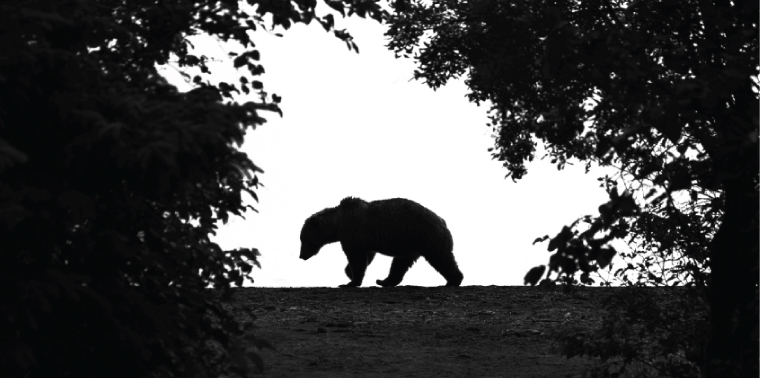This isn’t the first time this discussion has arisen. The grizzly was delisted in 2007, only to be relisted in 2009 after a collective of conservation groups sued.
But grizzlies could again be delisted in the next year or so. First, though, Servheen’s Interagency Grizzly Bear Committee, a partnership of federal and state wildlife agencies, must prove the animal can survive without a major food source, whitebark pine nuts, which is declining due to climate change.
While the agency continues to lay the groundwork for delisting, some hope ranchers and conservationists will find a middle ground that eluded them in the battle over the wolf.
Some, like Neal, aren’t optimistic. He says many ranchers don’t want to share the land with large predators. “Their granddaddies were successful in getting rid of this 100 years ago. They don’t see coexistence as their goal. They see victory as their goal,” he says.
But according to Jim Williams of Montana Fish, Wildlife and Parks, conservationists and ranchers are “working together really well. Ranchers have spent years altering the way they make a living to accommodate grizzly bears,” including installing electric fences and disposing of livestock carcasses promptly so they don’t attract predators, he says. “We need to figure out how to live with grizzlies,” he adds.
It remains to be seen whether such cooperation will last, once the delisting debate heats up in the months to come. When that does happen, the question of what belongs where will once again make us consider just how wild we want the land around us.
![]()
Ensia shares solutions-focused stories free of charge through our online magazine and partner media. That means audiences around the world have ready access to stories that can — and do — help them shape a better future. If you value our work, please show your support today.
Yes, I'll support Ensia!

- “Currently grizzlies are relegated to designated “recovery zones…” - This is not true. In fact hundreds of grizzlies live parts of the year outside of recovery zones. We even have females denning and having cubs outside recovery zones. When the grizzly recovery zone in Yellowstone was delineated in 1982, the distribution of grizzlies in the Yellowstone ecosystem was entirely within the Recovery Zone of 23,833 sq. km (Schwartz et al. 2002. Distribution of grizzly bears in the Greater Yellowstone Ecosystem, 1990-2000. Ursus 13:203-212.). In 2004, the distribution had increased to 36,364 sq km. By 2010, grizzly distribution had continued to increase to 50,280 sq km, which is 2.1 times the distribution in 1982 (Bjornlie, D.D., D.J. Thompson, M.A. Haroldson, C.C. Schwartz, K.A. Gunther, S.L. Cain, D.B. Tyers, K.L. Frey, and B.C. Aber. In press. Methods to estimate distribution and range extent of grizzly bears in the Greater Yellowstone Ecosystem. Wildlife Society Bulletin 000:000-000.).
In the Northern Continental Divide Ecosystem (NCDE) in Northwest Montana where there are 1000 grizzlies increasing at 3% per year, significant numbers of bears live outside the recovery zone line. There are no state or federal policies to “confine the bears” within the recovery zones and the facts of their expanding distribution confirm that.
- “All this management makes the grizzlies of today “the very definition of an open-air zoo population,” according Chuck Neal, a retired ecologist for the U.S. Department of the Interior and author of Grizzlies in the Mist. To have a truly wild, free-ranging population, he argues, “we must permit these bears to expand their habitat.” – This is not true. The expanding distribution of bears (detailed above) shows this statement has no basis in fact. This statement reduces the credibility of the article and of your publication.
- “But the states surrounding Yellowstone — Montana, Wyoming and Idaho —want just the opposite. Citing threats to livestock and public safety, they want to confine the bears to designated areas and thereby limit their numbers.“ – This is not true. In fact the states have been active partners in the recovery and EXPANSION in range and numbers of grizzly populations for 32 years. The states annually contribute hundreds of thousands of dollars and skilled management and research personnel toward conservation, management, education, outreach, and monitoring efforts and will continue to do so after delisting. We do have to manage bears when they get into conflicts on private lands but there is not a policy to “confine” bears anywhere. Hundreds of grizzlies live parts of their lives on private land with the support of the landowners, many of whom are cattle ranchers. Only a small percentage of grizzly bears every kill any cattle. The majority of grizzlies live in and among cattle with few conflicts. Management after delisting will not look much different than what occurs now under listed status and if hunting occurs it will be limited in scope all hunting mortalities will be carefully managed within sustainable limits so that hunting will never threaten grizzly populations (see the post-delisting management plans at: http://www.fws.gov/mountain-prairie/species/mammals/grizzly/continentalindex.html and
http://www.fws.gov/mountain-prairie/species/mammals/grizzly/Final_Conservation_Strategy.pdf).
- “These are “isolated, postage-stamp sized populations,” says Louisa Willcox with Natural Resources Defense Council. If “linkage corridors” were created between these disparate ecosystems and grizzlies were allowed to occupy all the habitat that’s suitable for them, that would result in a population of roughly 3,000, Willcox says. – In fact, an active linkage zone effort has been underway for more than a decade to identify and manage the areas between the large blocks of public land in the Northern Rockies (including adjacent areas in British Columbia) so that grizzlies and other wildlife species can move between these areas. Grizzlies have already moved between some of these areas and have gotten half way between the NCDE and Yellowstone. It is just a matter of time until the NCDE and Yellowstone are genetically connected with males moving between these ecosystems. As to the statement: “…that would result in a population of roughly 3,000, Willcox says”, what is the scientific basis for that number?